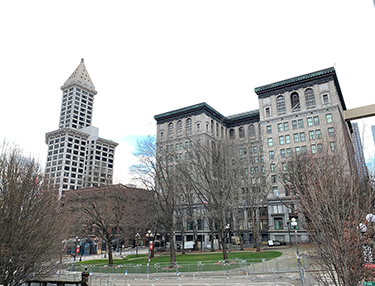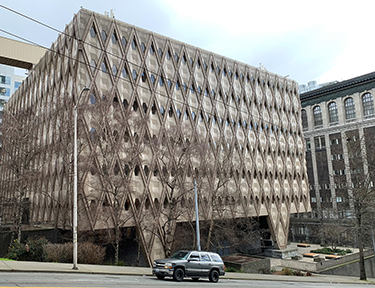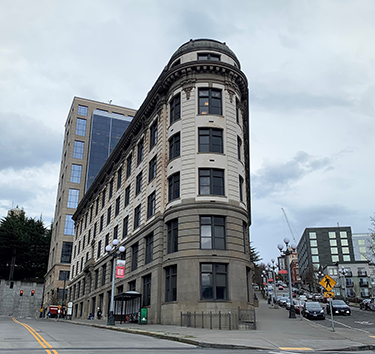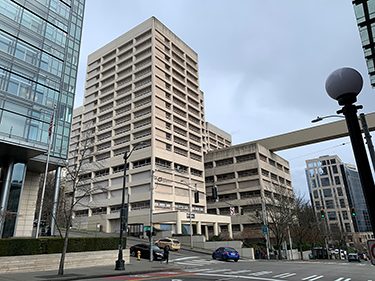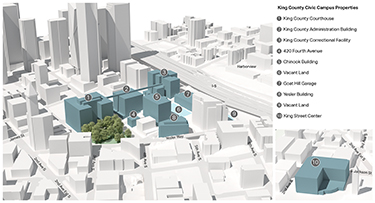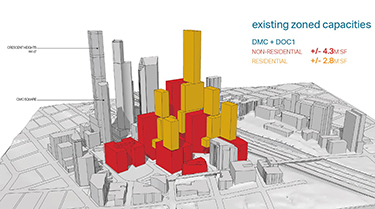|
Subscribe / Renew |
|
|
Contact Us |
|
| ► Subscribe to our Free Weekly Newsletter | |
| home | Welcome, sign in or click here to subscribe. | login |
Real Estate Buzz
| |
 Brian Miller Real Estate Editor |
March 9, 2023
On the Block: Dow drops a bombshell with downtown plan
King County Executive Dow Constantine made a lot of news Tuesday at his annual State of the County speech. Let's skip straight to the item of most interest to developers, architects, builders and planners.
At a time when downtown continues to struggle, when office workers — including those of the city and county — are resisting a full Monday-to-Friday return to cubicles, and when affordable housing and homelessness are top of mind, why not repurpose some of the county's prime real estate?
“We can turn this neighborhood into a vibrant place to live, to work, to visit and to thrive,” said Constantine. He proposed as a first step that Sound Transit move its intended future No. 2 line International District station, linking to the Eastside, up north to the site of the vacant King County Administration Building. That occupies a full block at 500 Fourth Ave.
He continued, “Rather than selling the land, I propose we keep it, and allow Sound Transit to build their new tunnel and station below. Their investment in infrastructure could set the groundwork for new development above, and jump start the reinvention of this old hillside.
“On some of the most valuable real estate in this region, we have a 9 to 5 workplace, rather than a 24-hour neighborhood. We have the chance to rethink and remake this vast urban tract in light of what it means to be a city today.”
Back before COVID-19, the county began a study for what's now dubbed the Civic Campus Initiative. It later took into account the pandemic. With consultant Northwest Studio, it said in 2020, “These properties could allow for a total of 4.3 million square feet of non-residential development capacity. If used for residential purposes, this could allow for more than 2,500 housing units.”
Constantine didn't offer any such numbers in his Tuesday speech. Nor was there any timeline offered, nor any suggestion of selling versus ground leasing other properties.
The county didn't respond before deadline to a DJC query about possible schedules, requests for proposals, new master planners, etc. And there likely aren't any concrete ideas now — other than the notion of ground leasing the 500 Fourth block. Both Sound Transit's board and the King County Council would have to approve that first step. Call it Phase I?
The county now has eight buildings on ten sites, some being full blocks. Its buildings total about 2.3 million square feet. The outlier is King Street Center, in Pioneer Square, which is too recent to raze. So, too, is the Chinook Building.
But the main concentration in the civic campus, clustered around the off-limits City Hall Park, offers over 6 acres for blue-sky reconsideration.
To begin with, that all has high-rise zoning. And the first candidate for being scraped and redeveloped is the ugly old administration building. The county began rethinking that white elephant last year, and the light-rail proposal emerged earlier this year.
Constantine also reiterated on Tuesday that the neighboring King County Correctional Facility (the jail), also with a full block, is likewise obsolete and destined for closure. That 37-year-old structure is linked by skybridge to the administration building and, downhill from that, the King County Courthouse.
The courthouse also has a full block, with an over century-old building that's more familiar than historic or architecturally distinguished. It has high ceilings and grand hallways in some areas; in others are cramped offices with dropped ceilings. And, of course, it's bounded by two very unpleasant sections of Third and Fourth avenues.
But, by virtue of its pre-A/C provenance, the 14-story building has prominent light and air wells and an H-shaped footprint that might make it suitable for — drumroll, please — conversion to apartments. (On a sloping site, it started at four stories above Fourth in 1916, with 10 stories added in 1931.)
And a few steps south is the flatiron-shaped Yesler Building, which dates to 1909 (with a 1970s addition). That seven-story structure has floor plates with around 11,000 square feet; and that's a number that could allow for efficient division into apartments. Constantine said on Tuesday that the Yesler Building and courthouse were both in need of costly restoration. He didn't mention apartments.
Of course, let's state the obvious: It'd be more efficient, and would yield far more units, to knock them both down and start with a clean sheet of paper.
Up near the freeway are some steep, vacant patches and a structured parking garage. Those are often called the county's Goat Hill properties. And there's a small corner building facing City Hall Park, which the county once sought to acquire from the city.
That deal fell through, but could be revived. And, immediately north of the court house is the full-block pit where the city's Public Safety Building was demolished so many years ago. Bosa Development owns it, has paused all efforts to build condos there, and it's also worth reconsidering. One could envision any number of downtown land swaps and ground leases among all three parties — or more. (Diamond Parking owns some key parcels on Fourth, also facing City Hall Park.)
The county began its Civic Campus Initiative in 2016. Northwest Studio delivered a briefing to the King County Council in January of 2020, just before the pandemic. Obviously, it's outdated now. But there are a few interesting numbers to glean.
Looking to 2045, county space needs were then projected to grow from some 2.1 million square feet to over 2.7 million square feet. The bulk of that increase, 54%, was projected to be offices.
Now, of course, office demand is radically diminished, and the county is in the position — like so many private employers — to shed space instead of growing it. Courthouse and jail needs are anticipated to increase more moderately. And that work can't be done from home. So the county's entire space portfolio needs to be rethought.
And, my thought, not Dow's: Why do the jail and courthouse need to be in downtown Seattle? Why? Just because they started there back in gold rush days? Why should we be beholden to that past? If we're going to rethink the civic campus, let's rethink the whole damn thing.
King County owns a lot of land, or could buy much cheaper land near future light rail stations in Kent, Federal Way or SeaTac. I won't say Bellevue or Redmond, because the land there is more costly. And if I were feeling puckish, I'd say, Why not put the jail and courthouse on Mercer Island? (If the city won't do an honest upzone for apartments, would it prefer prisoners?)
But, more seriously, and using Dow's own words: “Let's dream big.”
Got a tip? Contact DJC real estate editor Brian Miller at brian.miller@djc.com or call him at (206) 219-6517.
Previous columns:
- On the Block: The mystery of Crescent Heights, 03-02-2023
- On the Block: Exit the dragon? A Bruce Lee dojo changes hand, 02-16-2023
- On the Block: Bad news for Clarion in the CBD, 01-26-2023
- On the Block: Zillow joins the sublease parade, 01-12-2023
- On the Block: What will become of WSDOT's 4 acres in SoDo?, 01-05-2023
- On the Block: Holiday Gift Guide!, 12-08-2022
- On the Block: We need to talk about Wilburton, 10-06-2022
- On the Block: Is there more than Meta at the Spring District?, 09-22-2022



